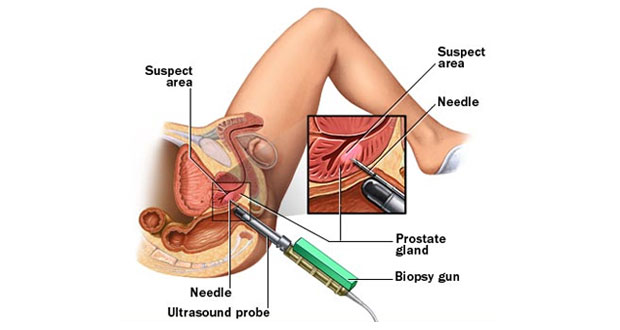TRANSRECTAL ULTRSOUND GUIDED PROSTATE BIOPSY
It is the most common way of performing a prostate biopsy.
What to expect during transrectal prostate biopsy.
In most cases, the urologist/radiologist performs a transrectal prostate biopsy. For this procedure, your doctor/radiologist will start by having you lie on your side, with your knees pulled up to your chest.
After cleaning the area and applying gel, your doctor/radiologist will gently insert a thin ultrasound probe into your rectum. Transrectal ultrasonography is used to create images of your prostate using sound waves. Your doctor/radiologist will use the images to identify the area that needs to be numbed with an anesthetic injection, if needed. The ultrasound images are also used to guide the prostate biopsy needle into place.
In most cases, an injection of a numbing medication is used to reduce the discomfort associated with the prostate biopsy. A needle is used to inject the anesthetic at various points near the base of the prostate.
Once the biopsy device is situated, your doctor/radiologist will retrieve thin, cylindrical sections of tissue with a hollow, spring-propelled needle. The procedure typically causes a very brief, uncomfortable sensation each time the spring-loaded needle takes a sample. Your doctor/radiologist may target a suspicious area to biopsy or may take samples from several places in your prostate. In most cases, doctors will take 10 to 12 tissue samples. The entire procedure usually takes about five to 10 minutes.
After the procedure
After a prostate biopsy, you’ll probably need to take an antibiotic for a few days. You may feel slight pain and have some light bleeding from your rectum. You may have blood in your urine or stools for a few days. You may also notice that your semen has a red or rust-colored tint caused by a small amount of blood in your semen. This can last for several weeks.
Contact your doctor if you have:
- Prolonged or heavy bleeding
- Severe pain
- Swelling near the biopsy area
- Difficulty urinating
In rare cases, a prostate biopsy can lead to infection. Signs and symptoms of infection include:
- Fever
- Pain when urinating
- Discharge from your penis
Currently
- Prostate biopsy is also done through perineal route
- This avoids risk of infection and allow surgeon to take samples at certain area not amenable through transrectal route.
If you have infection you need to see the doctor immediately for intravenous antibiotics.
 Urologist in Chennai | Robotic Urologist in India | Chennai Urology
Urologist in Chennai | Robotic Urologist in India | Chennai Urology

